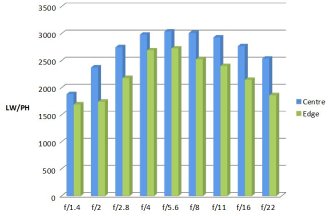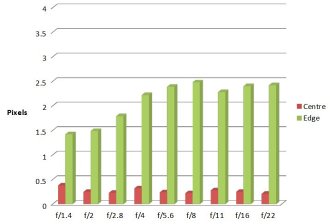Pentax SMC-FA 50mm f/1.4 Review
SMC Pentax-FA 50mm f/1.4 Performance
Of particular interest is how a film-era lens design will cope with the requirements of digital sensors, especially with high pixel counts. There was little thought with lenses made for film cameras of making telecentric designs, so it is reassuring to find that this lens is definitely up to the standard of the latest Pentax high quality zooms. (Telecentric design results in the exit light rays from the back of a lens being parallel, thus improving the peripheral illumination with a digital sensor. Film can accept more oblique rays without problems.)
Centrally, sharpness starts off quite soft at f/1.4, is of a good standard by f/2 and is very good from f/2.8 through to f/22. It peaks at f/5.6.
The edges also start off soft at f/1.4 and f/2, reach a good standard by f/2.8 and are very good from f/4 to f/8. There is a drop to good sharpness at f/11 and f/16 and a softening of detail at f/22. Again, performance peaks at f/5.6.
How to read our charts
The blue column represents readings from the centre of the picture frame at the various apertures and the green is from the edges.The scale on the left side is an indication of actual image resolution as LW/PH and is described in detail above. The taller the column, the better the lens performance.
For this review, the lens was tested on a Pentax K-1 using Imatest.
Distortion is a respectable -1.22% barrel, which is good for such a fast, bright lens design. CA (Chromatic Aberration) is very well controlled centrally, down to about one quarter of a pixel and resulting in no fringing being apparent. The edges do show some CA, but it is easily dealt with in software.
How to read our charts
Chromatic aberration is the lens' inability to focus on the sensor or film all colours of visible light at the same point. Severe chromatic aberration gives a noticeable fringing or a halo effect around sharp edges within the picture. It can be cured in software.Apochromatic lenses have special lens elements (aspheric, extra-low dispersion etc) to minimize the problem, hence they usually cost more.
For this review, the lens was tested on a Pentax K-1 using Imatest.
Images are bright and contrasty and have plenty of punch. There is an almost total resistance to flare, even with the sun just on the edge of the image area. In even the most demanding shots there is no loss of contrast because of flare. The colour balance of all Pentax lenses is excellent and this one is no exception. I would describe it as slightly warm natural colour. Colour balance across a lens range is desirable for consistency and the lens blends closely with even the newer HD coated optics.
The conclusion is that this lens still holds its head up high and can compete with the latest high quality full frame lenses as an equal. An excellent result for a well established design.
Value For Money
In the Pentax range there are some options for a bright full frame standard lens. The SMC Pentax-FA 50mm f/1.4 costs £339. The SMC Pentax 43mm f/1.9 Limited lens costs £629. Alternatively, the slower SMC Pentax-D FA 50mm f/2.8 Macro lens is priced at £319. Although not as fast it does offer 1:1 magnification.
To see how this relates to the cost of other marques, Canon offer the EF 50mm f/1.4 at £232, Nikon the 50mm f/1.4 G AF-S at £349 and Sony the 50mm f/1.4 AF at £299.
This suggests the Pentax is about at the right price level for a high quality, fast standard lens. There are of course some very low cost options, but these are usually 50mm f/1.8 designs. Sadly, the SMC Pentax-DA 50mm f/1.8 is for APS-C format only.
For more options have a look at to Top 10 Best Pentax Lenses, or the Top 27 Best Portrait Lenses.
Add your message
Please login here or if you've not registered, you can register here. Registering is safe, quick and free.
photodo Stats
428 MTF tests
74 in-depth photodo reviews
100+ users join each day
Help the lens community by reviewing or rating a lens today via our lens search
Latest Lens Reviews
- Chinon 28mm f/2.8 Vintage Lens Review
- Canon EF 70-200mm f/4L IS II USM Lens Review
- Samyang AF 85mm f/1.4 EF Review
- Sigma 70mm f/2.8 DG Macro Art Review
- Samyang AF 24mm f/2.8 FE Review
- Meike 50mm f/1.7 Review
- Tamron 70-210mm f/4 Di VC USD Review
- Lensbaby Burnside 35mm f/2.8 Review
- Asahi Super Takumar 50mm f/1.4 Review
- Asahi Super-Multi-Coated Takumar 135mm f/3.5 Review


